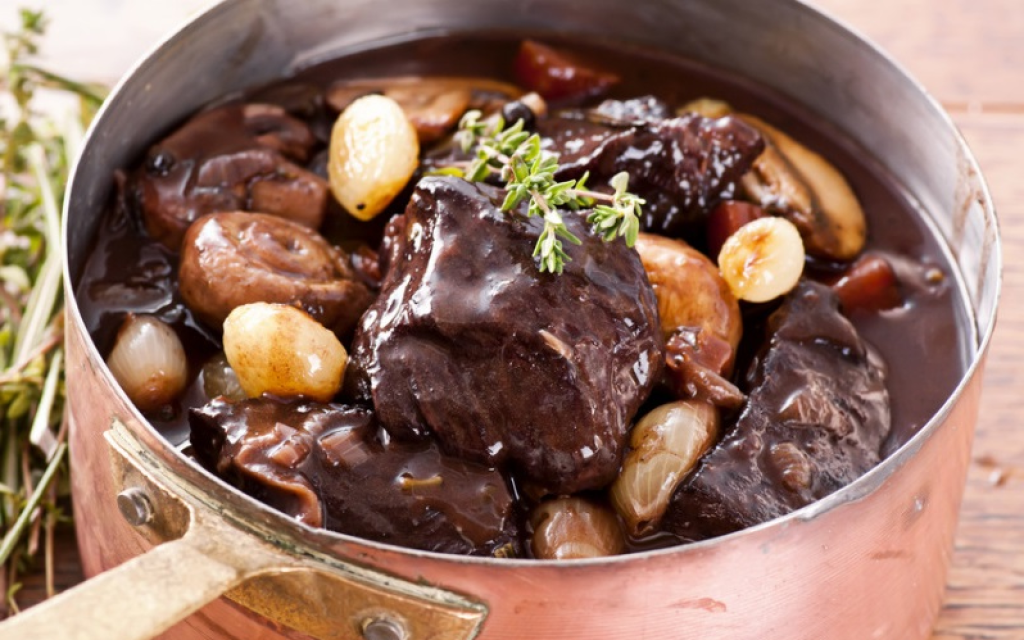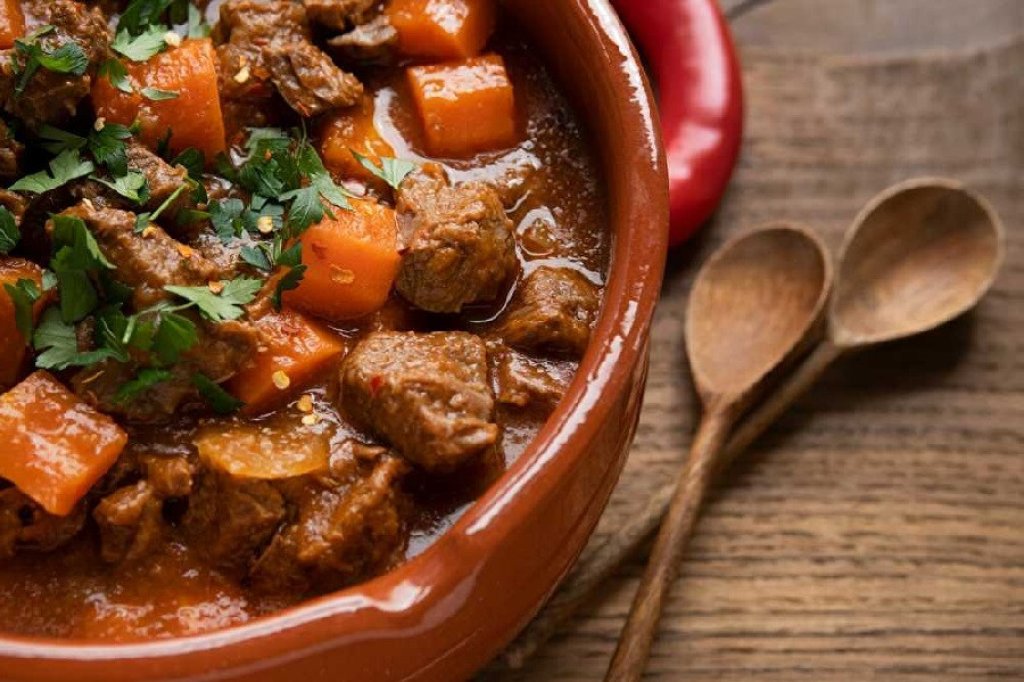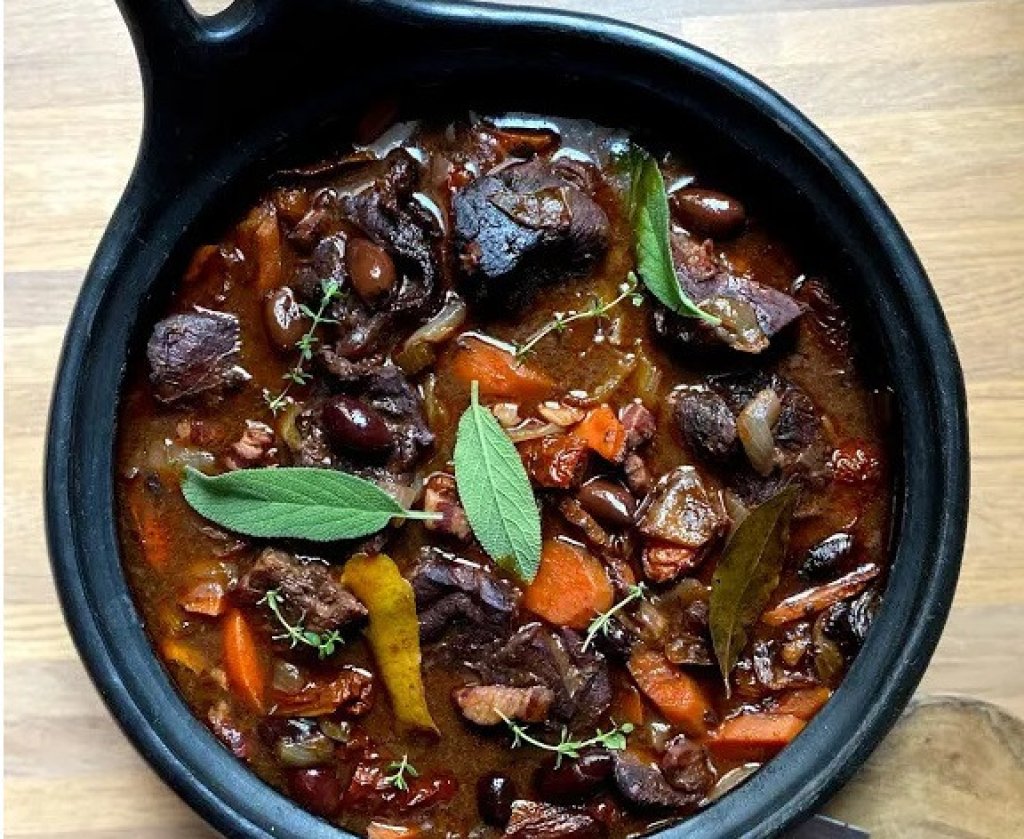We're taking you to the heart of Provençal gastronomy with this authentic recipe for daube. A tasty dish based on beef marinated in red wine, simmered for a long time to produce tender, flavoursome meat.

Easy to prepare, this daube is ideal served in a pressure cooker or daubière, for a culinary trip to Provence. Let yourself be seduced by this traditional recipe, a true emblem of regional cuisine.
Traditional Provençal daube recipe: the steps
Preheat the oven to 170°C.
Prepare the marinade: cut the meat into pieces, sprinkle with white or red wine, olive oil and cognac. Season and marinate for one day.
Prepare the garnish: brown the carrots, mushrooms, onion, cut-up meat, tomatoes and bacon in a cast-iron casserole dish. Then add the herbes de Provence and some orange zest. Moisten the meat with half the marinade and half the veal stock.
Close the casserole tightly with a bit of pasta.
Leave to cook for at least four hours.
You can serve this dish with pasta, rice or potatoes.

The origin and history of daube provençale
Provençal daube, rich in flavour, has a deep and fascinating history. It has its roots in the Provençal adobar, meaning "to prepare, to arrange", which gave rise to the word dòba, daube in French. From the outset, this dish was associated with a method of stewing, traditionally in an earthenware daubière.
In the 19th century, this dish became particularly popular in Provence. The "rouliers" or "charretiers", ancestors of today's truck drivers, popularised it as they travelled between the villages of Haute-Provence and the major towns. Each family had its own recipe, handed down from generation to generation.
Once considered a poor man's dish, daube provençale is now a staple of Provençal gastronomy, appreciated for its tender meat simmered in a red or white wine marinade from the vineyards of Provence.
Which meat for the daube?
In Provence, the traditional choice of meat for daube is beef. The preferred cuts are the beef cheek and the fleshy parts of the front knee, such as the galinette, for their tenderness after long cooking.
Beef cheek, rich in collagen, becomes particularly tender and tasty after a long simmer.
Galinette, which comes from the lower thigh of beef, is also an excellent option.
It is also common to leave a little fat on each piece, which helps to enrich the flavour of the dish. Finally, marinating the meat the day before is a crucial step: it tenderises the meat and infuses the flavours of the wine and herbs.
The secret of red wine marinade for a successful daube
The secret of a successful marinade lies in the balance of the ingredients and the length of the marinade. Red wine is the key ingredient, not only tenderising the meat but also giving it a unique flavour. Ideally, use a red wine from Provence or a Côtes du Rhône to keep with tradition.
Add herbs: onions, carrots, celery, garlic, bay leaves, thyme, parsley and orange zest. Peppercorns add a welcome touch of spice. Don't forget the cloves for an exotic touch.
The marinade should last at least 12 hours, but 24 hours is preferable for optimum flavour infusion. Keep your marinade in the fridge and make sure the meat is well submerged.
Here's a summary of the ingredients for the marinade:
Red wine from Provence or Côtes du Rhône
Onions
Carrots
Celery
Garlic
Laurel
Thyme
Parsley
Orange zest
Pepper seeds
Cloves
It's this harmony of flavours that will give your Provençal stew its distinctive, much-loved flavour.

Perfect cooking: time and method
To cook a daube provençale to perfection, it's essential to follow the correct steps and cooking times. After marinating, brown the meat on all sides in a casserole dish with lardons and olive oil. Then add the marinade and leave the wine to reduce.
According to tradition, the daube should simmer gently for several hours. A slow simmer of around 4 hours is ideal to obtain tender meat and a thick sauce. Patience is the key to a tasty, comforting stew.
For optimum cooking :
Brown the meat and bacon
Add the marinade and reduce
Simmer for 4 hours over a low heat
Don't forget to check the cooking regularly and add stock if necessary, so that the meat is always covered in liquid.
Daubière or pressure cooker: what equipment should you choose?
Each cooking utensil has its own advantages. The daubière, with its conical shape and gentle stewing, distributes the heat evenly and preserves the flavours of the stew. It's ideal for long, slow cooking, in keeping with Provençal tradition.
The pressure cooker, on the other hand, is renowned for its speed of cooking thanks to the high pressure it generates. It's a practical way of saving time, but may require you to adapt the recipe to avoid overcooking the meat.
For traditional, tasty cooking: opt for the daubière.
For fast, convenient cooking: opt for the pressure cooker.
So it all depends on your availability and cooking preferences.
Food and wine pairing: which wine to pair with a beef stew?
To bring out the best in your Provençal stew, the wine pairing is essential. While red wine is often preferred for its ability to support the flavours of the dish, other options are possible.
Red Cassis, red Bellet, red Bandol, red Pierrevert or red Les Baux de Provence are rather 'young', dry red wines that go perfectly with Provençal stew.
If you prefer a more robust wine, a powerful red wine, rich in alcohol, will bring out the greediness of the dish. The tannins, which should not be too firm but rather well coated, are ideal for the concentration of the sauce and its garnish.
Finally, if you opt for a lighter version of the daube, a dry white wine or a fruity rosé may also be a good choice to complement the aromas and flavours of this traditional Provençal dish.
Whatever wine you choose, make sure it's well-balanced and able to enhance your dish without overwhelming it.
Daube with white wine
White wine can be used instead of red wine to make a Provençal stew. Some people find that it gives this traditional dish a lighter, more airy feel. Choose a good dry white wine from Provence instead of red wine and you're done!
Enjoy a gourmet daube provençale
Many Michelin-starred chefs who love this traditional dish from our beautiful region have had fun reinterpreting Provençal daube in a gastronomic version. Such is the case with the charismatic Philippe Etchebest and other renowned chefs from all over Provence.
What's the difference between daube and boeuf bourguignon?
Daube provençale and boeuf bourguignon are equivalent recipes with a few subtle differences: daube can use whole pieces of meat, daube provençale can be made with white wine... but most of the time the recipes are the same. The daube uses more Provençal herbs, more olive oil, a bouquet garni, a stalk of celery... In short, we see daube provençale as a Mediterranean adaptation of boeuf bourguignon.
Which red wine is right for a beef stew?
To cook your Provençal stew, we recommend using a small Provençal wine, such as a Lubéron or Côtes du Ventoux wine. You need a powerful wine with flavour, but as you'll be cooking it, there's no need to use an expensive wine.
Discover all our Provencal recipes :
including our Provencal dessert recipes :













